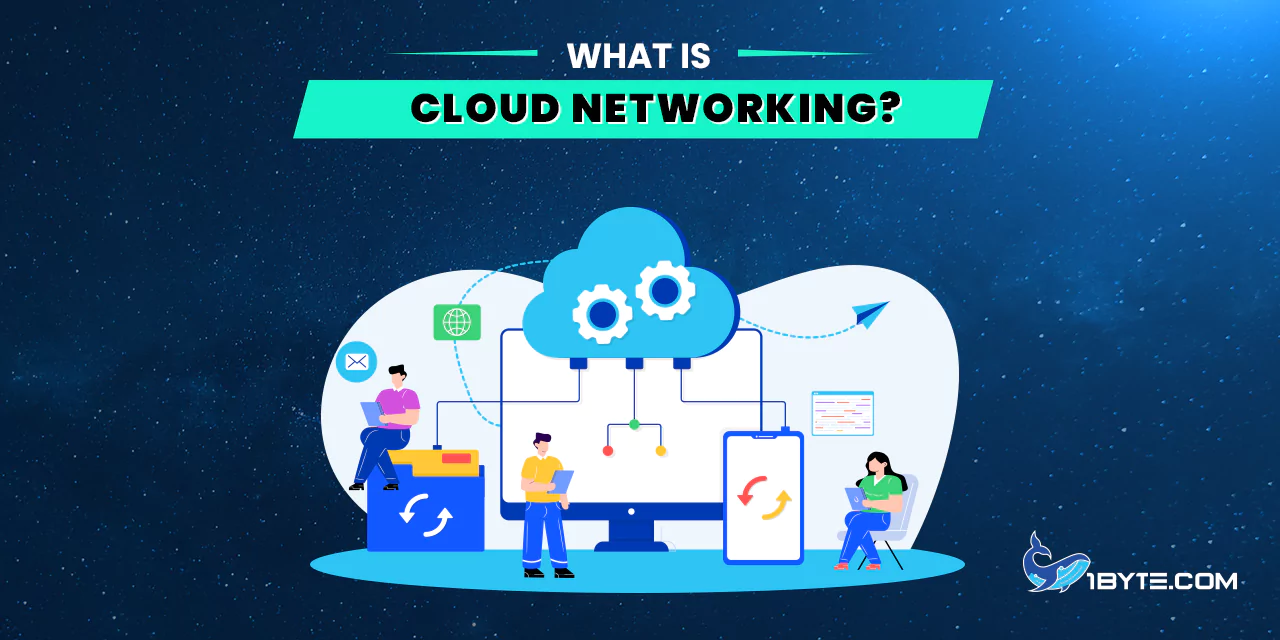In the digital age, where data and applications traverse the virtual realm, understanding what is cloud networking becomes paramount. Cloud networking is the backbone that enables seamless communication and resource sharing across a multitude of devices and locations. It revolutionizes traditional networking, offering businesses agility, scalability, and efficiency like never before.
This article unveils the intricacies of cloud networking, breaking down its core components, mechanisms, and benefits. From virtualization to software-defined networking (SDN), we embark on a journey to comprehend how the cloud transforms the way we connect, manage, and optimize our digital infrastructure. Whether you’re a tech enthusiast, a business owner, or a curious learner, grasping the essence of cloud networking is a doorway to harnessing the full potential of modern IT.
An Overview
At the heart of modern connectivity lies the concept of cloud networking. In essence, cloud networking reimagines how devices, applications, and data interact within the digital realm. Gone are the days of localized networks; today, cloud networking propels us into an era where resources are virtually boundless.
What is cloud networking?
Cloud networking encapsulates the evolution of networking in the digital age. It’s a paradigm shift from traditional hardware-based networking to a virtualized, software-driven approach. In essence, it’s the art of connecting devices, servers, and resources over the internet through cloud infrastructure.
In cloud networking, physical boundaries fade away, and resources are provisioned on-demand. Virtual networks, separated from physical hardware, enable efficient resource allocation. This agility allows businesses to scale up or down rapidly, adapting to changing demands.

The core idea behind cloud networking is to abstract the complexities of physical network management. This is achieved through software-defined networking (SDN), where network configurations are managed via software, enhancing flexibility and control.
Data security is a cornerstone of cloud networking, with encryption and authentication mechanisms safeguarding information across the network. This approach enhances protection, especially when data traverses public networks.
In essence, what is cloud networking revolves around harnessing the cloud’s power to create a dynamic, flexible, and secure network ecosystem. It’s about reimagining connectivity, enabling businesses to embrace the digital era’s demands with confidence.
Key components of cloud networking: virtualization, scalability, and automation
Virtualization, scalability, and automation are the cornerstones of cloud networking, shaping its transformative impact on modern IT.
Virtualization involves abstracting physical hardware into virtual instances. In cloud networking, this means creating virtual networks, switches, and routers, decoupled from physical counterparts. This empowers efficient resource utilization and isolation.
Scalability defines the ability to expand or shrink network resources based on demand. In traditional networking, scaling could be cumbersome; cloud networking makes it seamless. Resources can be allocated or released dynamically, ensuring optimal performance.
Automation takes center stage in cloud networking, streamlining operations through software-defined policies. Tasks that once required manual configuration can now be automated, enhancing efficiency and reducing human error.
Together, these components create a synergy that drives the essence of what is cloud networking. Virtualization brings flexibility, scalability adapts to change, and automation streamlines management. In this dynamic ecosystem, businesses thrive by aligning their network infrastructure with the pace of the digital age.
Traditional networking and cloud networking
Comparing traditional networking with cloud networking unveils a profound shift in how networks operate and serve modern needs.
Traditional networking relies on physical hardware—routers, switches, and cables—to establish connections. Each device requires manual configuration, which can be time-consuming and error-prone. Scaling often demands new hardware, causing delays and costs.
In contrast, cloud networking is virtualized and software-defined. Network elements are created, modified, or removed through code, enabling swift changes. This agility empowers businesses to adapt rapidly to changing demands.
Traditional networking often leads to overprovisioning, where excess hardware is purchased to accommodate peak usage. Cloud networking counters this with on-demand resource allocation. Resources are used efficiently, scaling up or down as needed.
Furthermore, cloud networking fosters better security. In traditional networking, securing physical devices is crucial. In the cloud, security is integrated into the virtual infrastructure, with encryption and authentication measures protecting data.
Recommended reading: 5 Essential Tools for Simplifying Cloud Infrastructure Management
How Cloud Networking Works
Understanding how cloud networking works unveils the intricate web of technologies that power this revolutionary approach to connectivity. It’s more than just transferring data; it’s about orchestrating virtual networks, enabling efficient resource allocation, and streamlining communication across a vast digital landscape.
Virtual networks and subnets in the cloud
In the realm of cloud networking, the concept of virtual networks and subnets takes center stage. Imagine a digital realm where the physical boundaries of hardware no longer define connectivity. Instead, virtual networks allow businesses to create isolated environments, each with its rules and configurations.
Virtual networks are like separate corridors within the digital landscape, where devices communicate as if they’re connected by physical wires. These networks enable efficient segmentation, making it easier to manage and secure resources. Within these virtual networks, subnets further refine the structure, dividing the space into smaller, manageable units.

Through subnets, resources can be organized based on function, security requirements, or other criteria. Each subnet can be assigned its IP range, enhancing isolation and facilitating smooth communication within the network.
In essence, virtual networks and subnets in cloud networking redefine connectivity. They offer flexibility, security, and ease of management that traditional networks struggle to match. As businesses navigate the digital landscape, these constructs serve as the foundation for efficient and dynamic communication.
Role of Software-Defined Networking (SDN) in Cloud Environments
Software-Defined Networking (SDN) is the mastermind behind the scenes of cloud networking, orchestrating connections and configurations with unprecedented agility. In a traditional network, configuring devices involves manual adjustments to each device. However, in cloud networking enabled by SDN, the control is centralized through software.
Think of SDN as the conductor of a symphony; it defines how traffic flows, where it goes, and how devices communicate. In a cloud environment, this orchestration happens virtually, allowing for rapid adjustments. If one area of the network experiences heavy traffic, SDN can redistribute the load to prevent congestion.
The beauty of SDN lies in its adaptability. As demands change, SDN can adjust network policies on the fly, optimizing performance and ensuring resources are allocated efficiently. This dynamic management enhances flexibility, reduces downtime, and ultimately provides a more responsive network.
Lastly, what is cloud networking without SDN? It’s like a symphony without a conductor. SDN empowers businesses to shape their networks to their needs, ensuring that the harmony of connectivity remains flawless even in the face of complex demands.
Connection to on-premises networks through VPNs or dedicated connections
As businesses embrace the capabilities of cloud networking, the question arises: How does the cloud connect with existing on-premises networks? The answer lies in two crucial methods: Virtual Private Networks (VPNs) and dedicated connections.
VPNs create a secure tunnel between the on-premises network and the cloud environment. This encrypted channel ensures that data traversing the internet remains confidential. It’s like a secret passageway that seamlessly bridges the gap between the physical and virtual realms.
On the other hand, dedicated connections offer a direct, high-speed link. It’s as if a private road connects your on-premises infrastructure to the cloud provider’s data center. This dedicated route minimizes latency and provides consistent, reliable performance.
Both approaches offer businesses the flexibility to extend their existing networks into the cloud without compromising security or performance. What is cloud networking without the ability to seamlessly integrate with existing infrastructure? VPNs and dedicated connections answer that question, enabling businesses to create a unified, efficient ecosystem where cloud and on-premises resources collaborate seamlessly.
Recommended reading: Virtual Networking Demystified: Understanding the Basics and Benefits
4 Benefits of Cloud Networking
Embracing cloud networking isn’t just a technological shift; it’s a strategic leap that unlocks a world of advantages for businesses. From flexibility to cost-efficiency, these benefits redefine the way organizations operate in the digital age.
Improved flexibility and agility for businesses
In the realm of cloud networking, flexibility and agility take center stage. Unlike traditional networks bound by physical hardware, cloud networking empowers businesses to adapt rapidly to changing needs.
Imagine adding new offices, users, or services without the hassle of procuring and configuring physical devices. Cloud networking allows for the creation of virtual networks and subnets on-demand, enabling businesses to scale effortlessly.

Moreover, cloud networking embraces the dynamic nature of modern business. As workloads fluctuate, resources can be allocated or de-allocated in real-time. This agility translates to cost savings, as organizations only pay for what they use.
What is cloud networking without the power to transform a business’s operational landscape? Improved flexibility and agility form the bedrock, enabling organizations to innovate and respond swiftly to evolving demands, setting a new standard for operational efficiency.
Efficient resource utilization through dynamic scaling
The power of cloud networking lies in its ability to optimize resource usage through dynamic scaling. Unlike traditional networks, where resources often remain underutilized, cloud networking adjusts resources in real-time.
Imagine a sudden surge in website traffic. In a traditional setup, excess hardware might be needed to handle the load. However, with cloud networking, resources can scale up automatically to accommodate the demand. When the traffic subsides, the resources scale down, preventing wastage.
This dynamic scaling minimizes costs by ensuring that resources are allocated precisely when needed. It also enhances performance, as applications and services receive the resources they require without delays.
In a nutshell, what is cloud networking without the ability to optimize resource allocation? Efficient resource utilization through dynamic scaling represents a strategic advantage, where businesses can confidently meet varying demands without overprovisioning or compromising performance.
Enhanced security and centralized management
In the realm of cloud networking, security is a paramount concern. With data breaches and cyber threats on the rise, businesses require robust measures to safeguard their digital assets. This is where cloud networking shines, offering enhanced security through centralized management.
In traditional networks, managing security across various devices and locations can be challenging. However, in a cloud networking environment, security policies and configurations can be centralized and applied uniformly. This not only streamlines management but also ensures consistency in security measures.
Additionally, cloud networking often comes with built-in security features, such as firewalls, intrusion detection systems, and encryption. These layers of protection fortify the network’s defenses against potential threats.
Cost savings compared to traditional networking setups
One of the compelling advantages of cloud networking is the potential for significant cost savings when compared to traditional networking setups. In a traditional model, setting up and maintaining physical hardware, such as routers and switches, can incur substantial upfront and ongoing costs.
However, cloud networking operates on a pay-as-you-go model. This means businesses only pay for the resources they use, eliminating the need for large capital investments upfront. Moreover, the flexibility to scale resources up or down allows for efficient resource allocation, reducing unnecessary expenses.
Maintenance and management costs are also streamlined in a cloud networking environment. Updates, patches, and configurations can be automated, reducing the need for extensive IT personnel and freeing up resources for other strategic initiatives.
Recommended reading: What is Container Orchestration?
3 Future Trends in Cloud Networking
In this final section, we delve into the imminent future of cloud networking. From the rise of edge computing to the integration of AI-driven optimizations, these trends provide a glimpse into the enhanced capabilities that await organizations as they embrace the full potential of cloud-powered networking solutions. Let’s explore the path ahead and discover the exciting prospects that lie beyond the horizon.
Evolution of Network Automation and AI-Driven Optimizations
The future of cloud networking is tightly intertwined with the evolution of network automation and AI-driven optimizations. As organizations embrace more complex and distributed networks, manual management becomes less practical.

Enter network automation: a concept that involves using scripts, policies, and orchestration to configure and manage network devices and services. This trend is set to surge as businesses seek to streamline operations, minimize human error, and rapidly adapt to changing demands.
Moreover, the integration of artificial intelligence (AI) and machine learning (ML) into cloud networking opens doors to unprecedented optimizations. AI-driven algorithms can analyze vast datasets to predict network trends, detect anomalies, and make real-time adjustments. This not only enhances performance but also strengthens security measures.
Integration of edge computing and cloud networking
In the landscape of cloud networking, the convergence of edge computing holds immense promise for the future. Edge computing involves processing data closer to its source, reducing latency and enhancing real-time capabilities. When combined with the power of cloud networking, a new realm of possibilities emerges.
The synergy between edge and cloud brings data processing capabilities to the edge of the network, enabling faster responses and improved user experiences. This integration is particularly crucial for applications that demand real-time insights, such as IoT devices and industrial automation.
As we ponder what is cloud networking in the future, the harmonious relationship between cloud resources and edge computing resources plays a pivotal role. Businesses can enjoy the best of both worlds – centralized management and processing power in the cloud, coupled with the agility and low latency of edge computing. This trend will undoubtedly reshape how industries operate and innovate in the times to come.
Continued growth of cloud-native networking solutions
The trajectory of cloud networking points towards the continued expansion of cloud-native networking solutions. These solutions are tailor-made for the cloud environment, offering seamless integration, scalability, and adaptability.
As businesses increasingly adopt cloud services, the demand for networking solutions that complement cloud infrastructure becomes more pronounced. Cloud-native networking leverages microservices architecture, allowing for modular and independent components that can be easily scaled and managed. This approach aligns perfectly with the agility and flexibility that cloud networking promises.
Moreover, cloud-native networking solutions simplify the orchestration and management of complex networks, enabling automatic scaling and provisioning of resources. This trend addresses the challenges of maintaining intricate networks and ensures smooth operations in dynamic cloud environments.
In contemplating what is cloud networking in the future, the growth of cloud-native networking solutions stands out as a transformative force. This evolution streamlines operations, maximizes resource utilization, and empowers businesses to navigate the intricacies of modern networking with greater ease and efficiency.
FURTHER READING: |
1.Virtual Machine Host 101: Everything You Need to Know |
2.How to Choose a Web Hosting Provider That Meets Your Needs |
3. How Virtualized Infrastructure Transforms IT Operations |
Leverage 1Byte’s strong cloud computing expertise to boost your business in a big way
1Byte provides complete domain registration services that include dedicated support staff, educated customer care, reasonable costs, as well as a domain price search tool.
Elevate your online security with 1Byte's SSL Service. Unparalleled protection, seamless integration, and peace of mind for your digital journey.
No matter the cloud server package you pick, you can rely on 1Byte for dependability, privacy, security, and a stress-free experience that is essential for successful businesses.
Choosing us as your shared hosting provider allows you to get excellent value for your money while enjoying the same level of quality and functionality as more expensive options.
Through highly flexible programs, 1Byte's cutting-edge cloud hosting gives great solutions to small and medium-sized businesses faster, more securely, and at reduced costs.
Stay ahead of the competition with 1Byte's innovative WordPress hosting services. Our feature-rich plans and unmatched reliability ensure your website stands out and delivers an unforgettable user experience.
As an official AWS Partner, one of our primary responsibilities is to assist businesses in modernizing their operations and make the most of their journeys to the cloud with AWS.
Conclusion
In the world of modern networking, understanding what is cloud networking is paramount. Cloud networking offers businesses a dynamic and efficient way to manage their network infrastructure, enabling them to harness the power of the cloud for enhanced performance and scalability.
From its foundational concepts like virtual networks and subnets to its advanced trends like AI-driven optimizations and edge computing integration, cloud networking is an ever-evolving landscape that holds immense potential for businesses across various industries.
As technology continues to evolve, embracing cloud networking ensures businesses stay competitive and agile. With benefits like improved flexibility, efficient resource utilization, enhanced security, and cost savings, the adoption of cloud networking has become a strategic imperative.
As organizations continue to explore the possibilities of cloud networking, it’s crucial to stay updated with the latest trends and developments. By staying informed and adapting to these changes, businesses can unlock the full potential of cloud networking and propel themselves into a future marked by seamless connectivity, scalability, and innovation.

